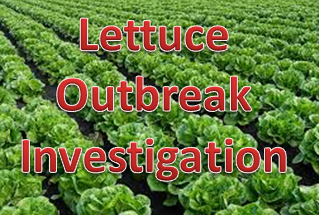The FDA issued a report on findings from the investigation of the California-linked romaine lettuce outbreak of E. coli O157:H7 in November 2018

Samples of soil, animal feces, fertilizer, agricultural water, and reservoir sediments were collected in the implicated farms in the traceback investigation. The CDC found one match to the outbreak strain of E. coli O157:H7 in the sediment of an on-farm water reservoir, used for irrigation by Adam Bros. Farming Inc., in Santa Barbara County. The strain was not detected in any other sample collected during this investigation. On December 17, 2018, the farm issued a recall of romaine lettuce and other products (red leaf lettuce, green leaf lettuce and cauliflower) that could be contaminated due to use of water from the same reservoir.
Currently, the FDA believes that the use of water from the reservoir was the source of the lettuce contamination, since the outbreak strain of E. coli O157:H7 was found in sediment from the reservoir and in no other sampled locations. This does not explain how lettuce grown on other farms got contaminated. Therefore, this particular farm cannot explain the entire outbreak.
Adam’s Bros farm treated the agricultural water with a sanitizer before use. However, the records did not document if it applied sufficient sanitizer to eliminate pathogens present in the water. It is not clear how the outbreak strain entered the water reservoir. The E. coli O157:H7 strain might have been there for months or even years. Alternatively, it could have been introduced into the reservoir from an unknown source. Near the reservoir, there was evidence of wild animal activity (waterfowl, rodents, coyotes, etc.)
To help ensure that leafy greens are safe and to reduce the potential of future contamination, it is important to understand where leafy greens are grown and harvested. While the FDA’s first goal is to prevent future outbreaks, it must have the tools to identify the growing region or specific suppliers of suspected shipments, if an outbreak happens. The FDA recommends that growers of leafy greens label the products with information such as harvest date and the growing region. They also recommend that all personnel in the leafy greens industry thoroughly review current operations, procedures, policies, and practices taking into consideration the findings of this investigation report.
The industry should make the necessary modifications to operations, procedures, policies, and practices to ensure safe products for consumers and minimize the likelihood of similar outbreaks in the future.
The FDA emphasizes the importance of the adoption of technologies to trace product from the field to the consumer in real time. The agency announced that it has already started special microbiological surveillance sampling assignments for romaine lettuce that is grown for distribution throughout the country. If samples are found to be contaminated, the FDA will follow up with the responsible farms to assure that they remove contaminated products from the market. The agency will also work with responsible farms to determine issues and identify steps they can apply to prevent contamination in the future.
Dr. Gottlieb said that “We urge all segments of this industry, from farm to table, and our government partners to review the findings of our investigation and make necessary changes. We recognize and appreciate the efforts that the leafy greens industry has taken to date. But together, we also know more must be done on all fronts to help prevent future foodborne illness outbreaks. We remain committed to further strengthening the FDA’s food program and applying our food safety expertise as we work to better safeguard the U.S. food supply.”
